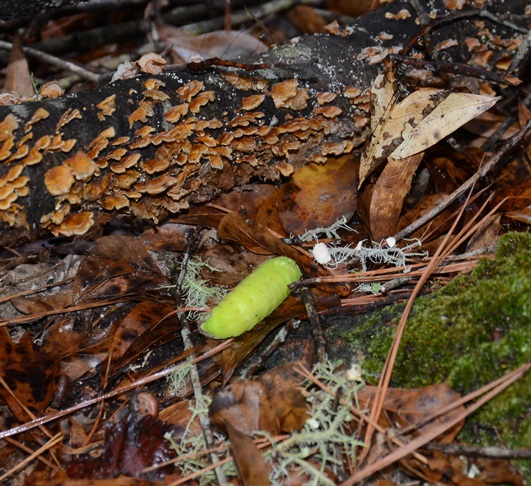
by Les Harrison | Jan 22, 2015

Fallen leaves add much to the landscape. They feed the plants and many insect, retain water, and help stabilize the soil
For the homeowner who feels the need to rake leaves and pine needles, the task can be something of a minor nuisance. The showers of earth-toned leftovers appear suddenly and at inconvenient times, and their removal is never added to a chore list without dispute.
Disarray aside, these organic remnants provide far more benefits than problems. Their suburban untidiness becomes an insulating blanket which nurtures plants, animals, and insects with time released nutrients for use by the efficient and fortunate in the wild and those of us in civilization.
First and foremost, leaf litter is critical to the water holding capacity of the woodlands. The dried leaves, needles and twigs absorb and shade rainwater from the evaporative effects of the sun and wind.
When heavy rains inundate the soil causing flooding and runoff, it is the leaves that act as part of the natural delaying system to minimize the negative impact on streams, creeks and rivers. The delayed or halted runoff provides time for water to be absorbed by the soil and be filtered by the natural screening capacity of this organic material.
The moisture works in conjunction with native bacteria and fungus to convert the leaf litter into nutrients usable by plants and trees. While not as concentrated as commercial fertilizers, many of the same plant nutrients are present in the decaying leaf litter.
The decomposition is aided by a variety of insects and worms which nest in, eat and overwinter under the debris. The animal activity breaks up and stirs the elements along with inoculating microbes in the matter which speeds nutrient availability to plants and trees during ideal years.
Luckily, the region’s leaf drop is spread over months with the plants and trees responding to the solar cycle and weather. Autumn, winter and spring each bring defoliation of specific trees and plants.
During dry years the bug and bacteria activity slows in accumulated leaf litter, but the naturally occurring fire cycle continues the nutrient recycling under the tree canopies. The easy to burn material aides in controlling insects and plants that can aggressively overpopulate an area if unchecked.
Controlled burns also prevent destructive wildfires which are harmful to all north Florida residents. While these uncontrolled fires do deposit nutrients, they have many negative effects which far outweigh this single benefit.
January’s weather is part of a continuing natural succession which the native plants and trees incorporate to continue the wild beauty so common in the region. The current cold and rain will combine with the leaf drop to produce much growth in the next few months.
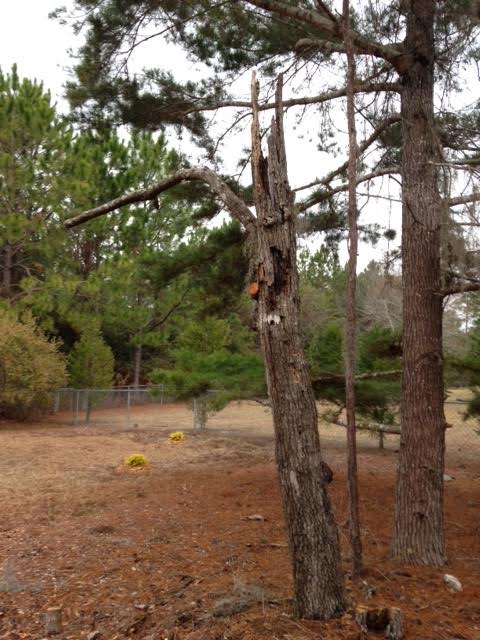
by Julie McConnell | Jan 13, 2015
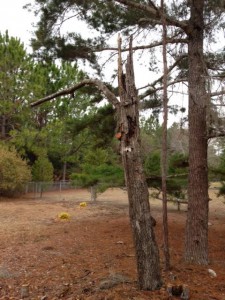
This dead oak tree was trimmed up to make it neater. It is ready for a wildlife resident! Photo: JMcConnell, UF/IFAS
One of the management issues that any landowner will face at some point is what to do when a tree dies in the landscape. The logical response is “cut it down,” but depending on the location and the size of the tree, that may not be necessary and you could be removing potential wildlife habitat.
With any other major decisions about your landscape, always consider safety first. If the tree is in a location where it could damage property or cause harm to people or domesticated animals then it should be properly removed. But what about those trees that are along wood lines or in the far reaches of the yard and not threatening person or property?
Consider leaving the entire tree or modifying it to make it more aesthetically pleasing yet still useful to wildlife. Weak branches or unstable tops may be removed to make the snag less of a risk or to look a little neater.
Some examples of animals that may use dead trees in the landscape are birds, bats, squirrels, frogs, and lizards. Besides the obvious cavity dwelling creatures such as woodpeckers, owls, and bats that are attracted to decaying trees, other animals will be drawn for other reasons. Dead trees in the landscape will become inhabited by insects and fungi which are terrific food sources for birds, mammals, amphibians, and reptiles!
To learn more about providing wildlife habitats in your landscape, please see the EDIS publications listed below or contact your local extension office.
Helping Cavity-nesters in Florida
A Birds-Eye View: How Birds Select Habitat
Dead Wood: Key to Enhancing Wildlife Diversity in Forests

by Carrie Stevenson | Jan 13, 2015
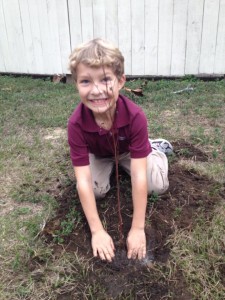
Planting a tree is an excellent way to insure clean air and water in the future. Photo credit: Carrie Stevenson
Most of us begin a new year with resolutions–to exercise more, to eat right, to spend our time more productively–but few things have as many lasting impacts for the future as the simple act of planting a tree.
Arbor Day (which literally means, “Tree Day”) was founded in 1872 by J. Sterling Morton, a naturalist and journalist in Nebraska. By 1882, it was celebrated by thousands of schoolchildren nationwide, who planted trees and took care of them with their classmates. Today, millions of communities and schools celebrate Arbor Day all over the world. Trees provide endless benefits, including shade, recreation, food and building products, shade and wind protection, wildlife habitat, oxygen production and carbon dioxide uptake.
Arbor Day is typically celebrated in the United States on the last Friday of April, but as ideal tree-planting conditions differ by climate, each state has its own specific Arbor Day, as well. Winter is the ideal time to plant trees in Florida, because it allows roots to develop without expending energy on growing new leaves and shoots. Our state celebration this year is January 16th.
Many local communities in Florida hold special events around this time. Be sure to check with your local Extension office or Native Plant Society chapter to find out if they are offering free trees or public events this month. For more information on the best trees for your area, be sure to take the time to read “Native Trees for North Florida” or peruse the UF Environmental Horticulture web page.
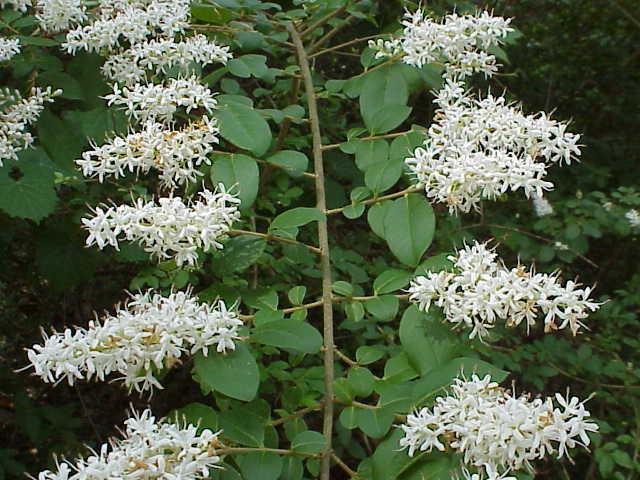
by Beth Bolles | Jan 13, 2015
The Chinese privet, Ligustrum sinense, is a plant that is well known to many people as a great nuisance in the landscape. It is also a Florida noxious weed because of its invasive nature.
Originally grown as an ornamental that formed a hedge and tolerated poor conditions, the Chinese privet has now spread to natural areas and grows easily on disturbed soils. Plants are full of white fragrant flowers in the spring with abundant small black fruit forming late summer and remaining into the winter. Seeds are easily spread by wildlife to new areas but new plants can also grow from roots.
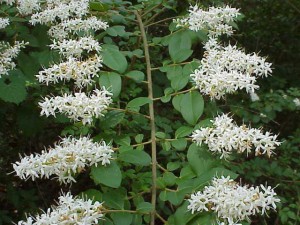
Privet may be best identified when it is in bloom.
Chinese privet easily forms a thicket, shading areas and impacting the growth of native plants. Homeowners can identify any plants growing on their property and work to manage Chinese privet when plants are not in seed. If you need assistance in identification, contact your local Extension office or view pictures online.
Even though homeowners will not find Ligustrum sinense in the nursery, cultivars of this plant may be found. One newer selection is ‘Sunshine’. This is a reportedly sterile cultivar that grows much smaller and has yellow foliage. Homeowners who choose to install ‘Sunshine’ may still need to be cautious since there has not been extensive research in Florida to verify that it will not become a future issue.








